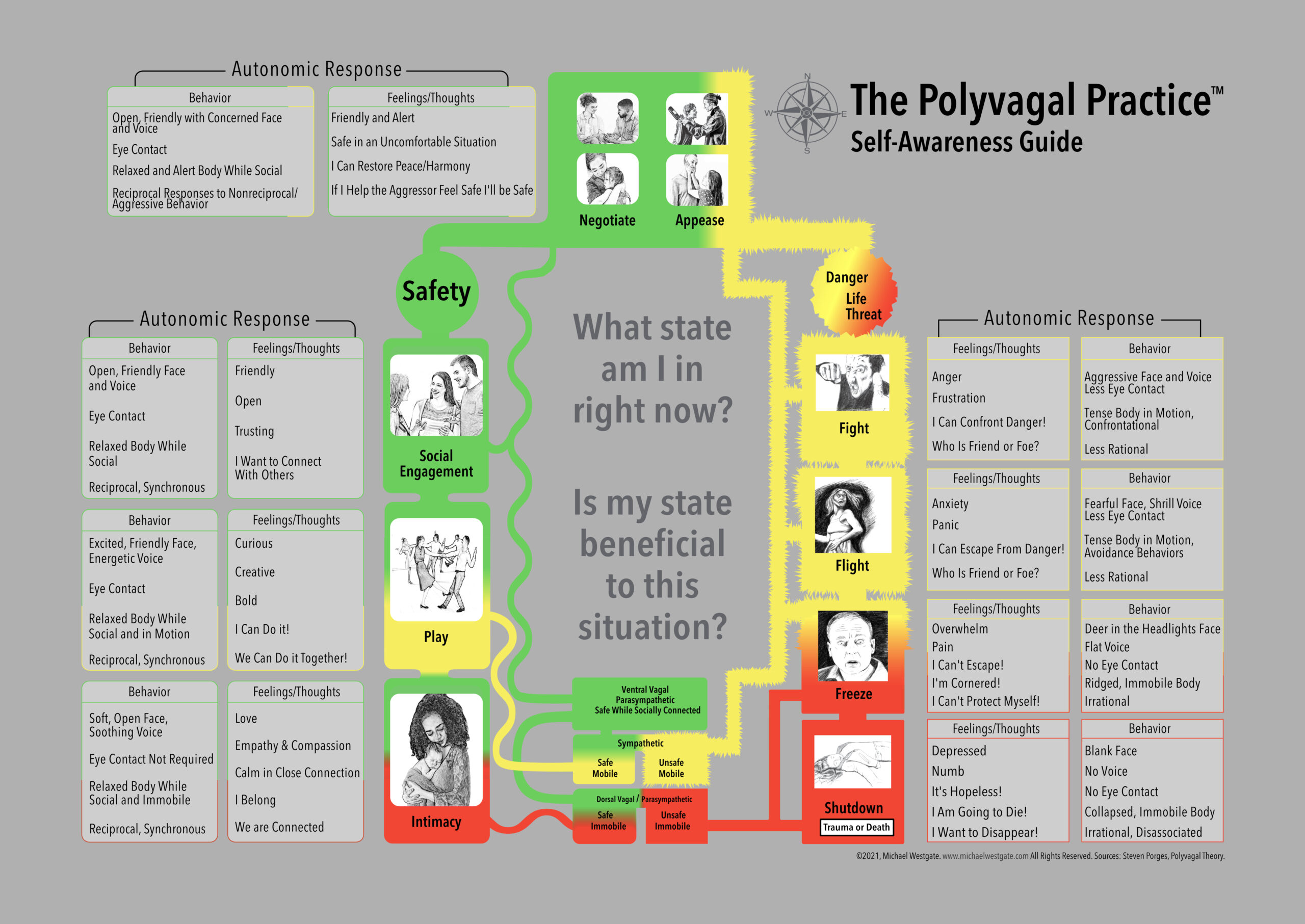Why Is the Vagus Nerve Important To Your Health?
(The video provides a brief overview; read the article below for a more in-depth understanding.)
Are you or someone you know suffering from conditions like anxiety, depression, PTSD, autoimmune disease, and chronic pain issues like fibromyalgia? If so, understanding the Vagus Nerve can be a game-changer for your recovery. This new understanding comes from breakthroughs in modern neuroscience, identifying that a dysfunction of the Vagus Nerve is a key element in most chronic health conditions. Essentially, overwhelming stress can overload our body’s capacity to process difficult experiences leading to our unconscious nervous system constantly acting as if it is being attacked by a threat even when no threats exist. If this condition persists for days, months, and years the body wears down and chronic issues start showing up.
Understanding how this trouble starts and what to do to ease your suffering requires some foundational knowledge.

Vagrant or Vagabond
Therefore, it’s essential to start with the basics: what is the origin of the word Vagus? It’s from the Latin “vagal,” which means wandering and is also the root of words like vagrant or vagabond. The word wandering is a perfect name for this nerve because it wanders from your face, around your heart and lungs, and your internal organs. Please note that in the following illustration, I have colored the Vagus Nerve yellow.
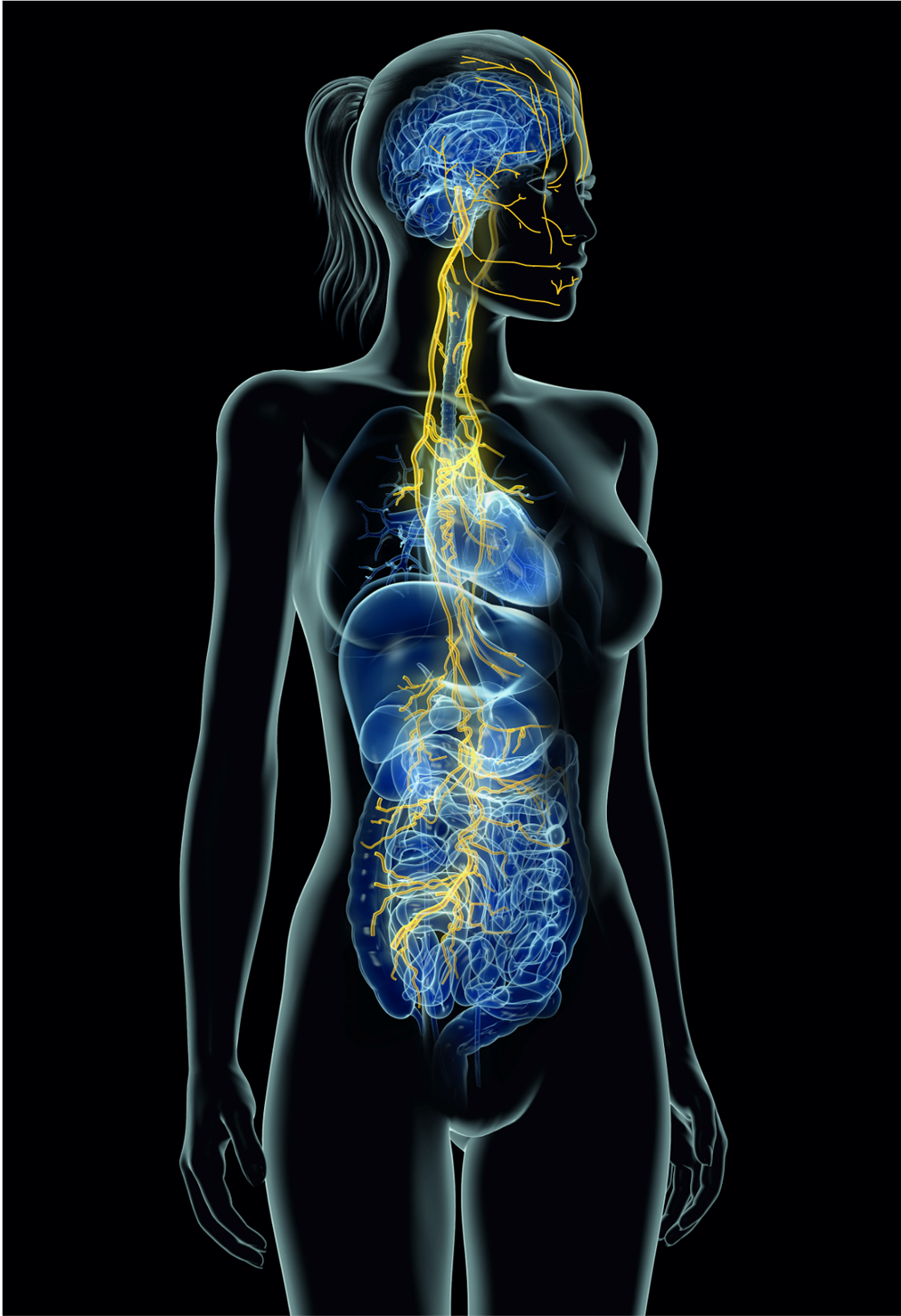
The Vagus Nerve is Colored Yellow
And just so there’s no confusion. I want to clarify: we’re not talking about the Las Vegas nerve, which is associated with wild partying behavior, and a desire for no one to know what you did after the fact. That subject would be for a different article.

The Las Vegas Nerve
What does the Vagus Nerve do?
The Vagus Nerve’s function is to adjust your physiology, so you respond adaptively to your environment. Adapting successfully includes adjusting the heart and lung rate, hormone levels, blood flow, digestion, etc., to optimize your chance of survival. For example, imagine the difference in your physiology when you run for your life from a tiger compared to going to sleep at night when you’re safe. Your physiology would be quite different in these two scenarios.
Essentially, the Vagus Nerve connects the brain in your internal organs, including your heart and lungs to the brain in your head. The messages sent through the Vagus Nerve are called vagal tone, like a musical tone. The tone changes depending on the challenges or opportunities in front of you from moment to moment. As the tone changes, so will every aspect of your physiology and psychology. Therefore, the Vagus Nerve facilitates these changes by acting as an information superhighway that connects our brain to our body. Ultimately, the tone sent through the Vagus Nerve determines how you respond to your environmental sights, sounds, people, and the news story you just watched on your smartphone.
Evolution gave us three survival brains.
Dr. Steven Porges, the author of Polyvagal Theory, believes that three distinct evolutionary stages determine how our nervous system organizes itself for responding to opportunities or threats in the environment.
According to Dr. Porges, our autonomic nervous system has ancient nerve pathways that unconsciously control how we respond to the world. Each of the three brains has a unique temperament and strategy for solving problems. At any given moment your unconscious nervous system will choose one of them to become dominant and suppress or modify the influence of the other two brains.
The most ancient of these brains is our Old Vagus which developed hundreds of millions of years ago when we were reptiles. The primary survival strategy of the Old Vagus in the face of overwhelming threat is to play dead, which is why I call it the Shutdown Brain.

The Old Vagus Developed When We Were Reptiles
The right branch of the Vagus Nerve is linked with the Old Vagus; it wanders from the right side of the neck into the heart and lungs, then through the gut/internal organs.
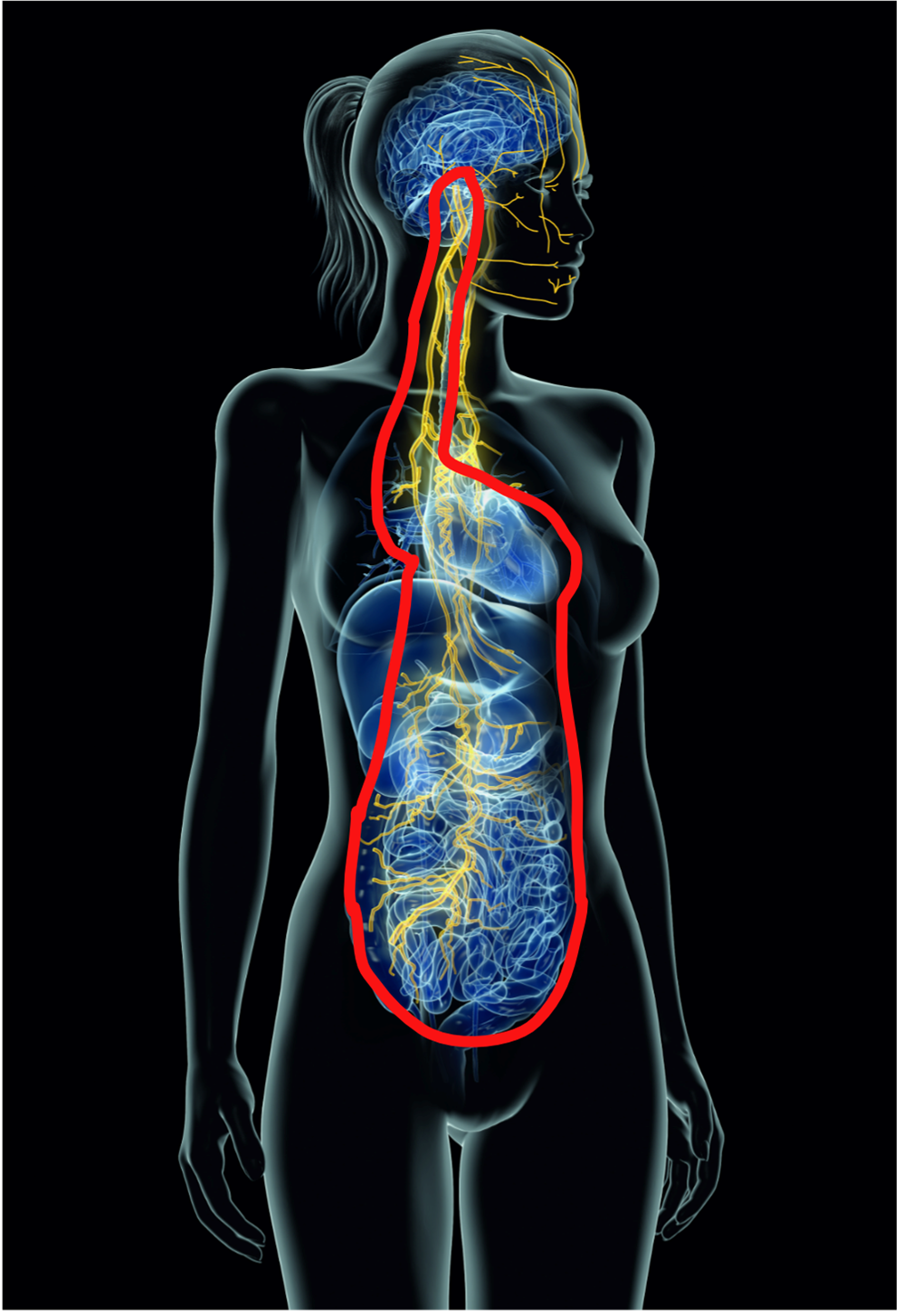
The Right Branch of the Vagus Nerve
Then hundreds of millions of years later, the Sympathetic Nervous System developed as we evolved into tree-dwelling primates. The Sympathetic Nervous System helps us survive by activating aggressive and defensive actions in response to threats which is why I call it the Action Brain. As you can see in the photo, this primate is acting assertively, showing teeth, possibly in response to another mammal.

We Developed the Sympathetic Nervous System (Action Brain) as Primates
With the addition of the Sympathetic Nervous System allowing us to fight & flight, we had more options for survival. When facing challenges, we could fight off threats or run away from them. If we run away and the danger caught up with us, we can still play dead by activating the Old Vagus (Shut Down Brain).
Our Action Brain is in our spinal cord, as shown in the illustration below in yellow.
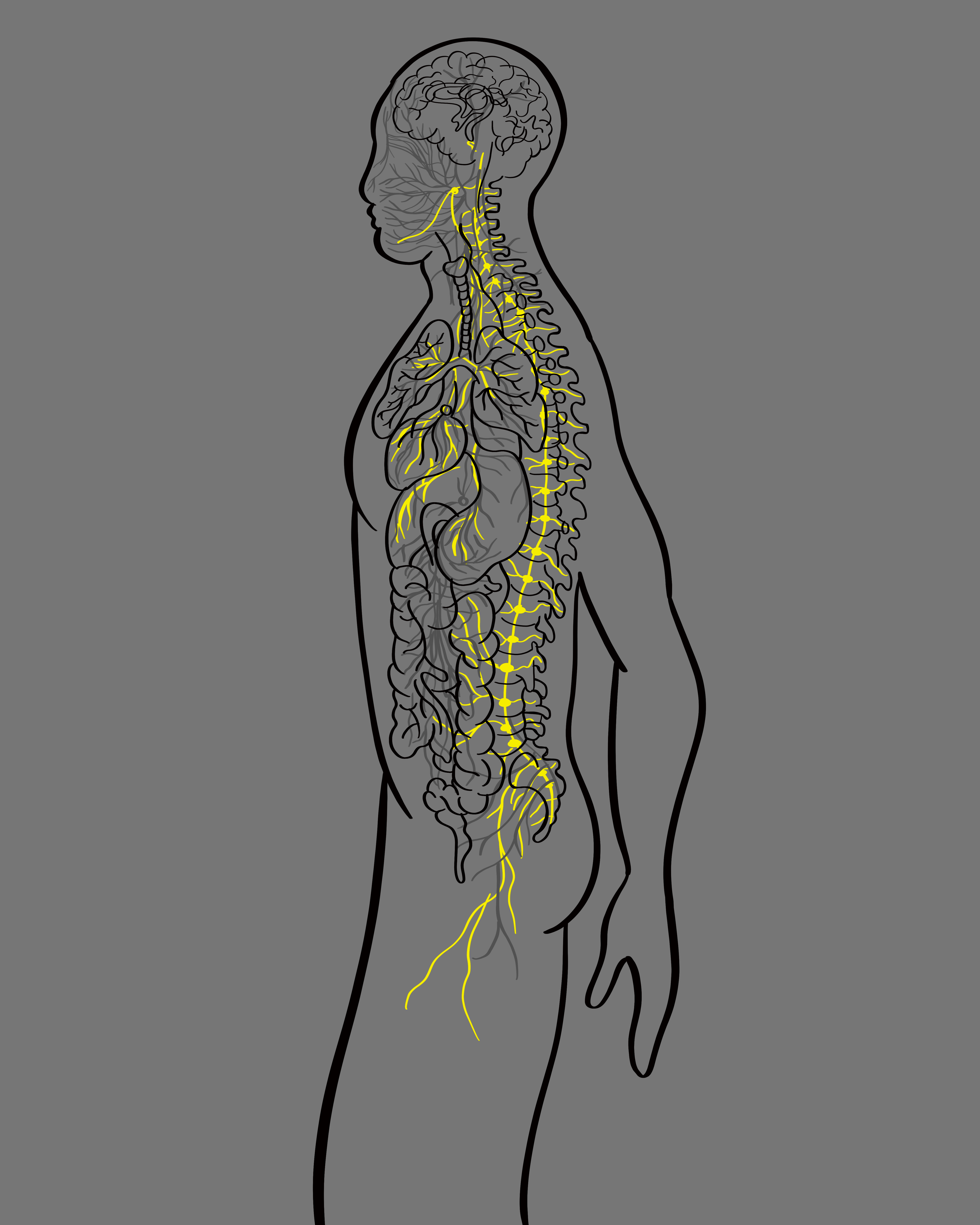
The Sympathetic Nervous System (Action Brain) is Yellow
Then hundreds of millions of years later, we developed into humans, which included the addition of a new part of our nervous system, the New Vagus, responsible for civilized behavior. Dr. Porges hypothesized that the primates that cooperated socially more effectively were the ones that survived and reproduced more often. New nervous system pathways developed from this highly cooperative behavior, including deep learning, deep spiritual states, play, social cooperation, and many other positive aspects of being a healthy and prosperous human. Most importantly, this special wiring is only available when we are successfully bonded to other people, which is why I call it the Calm Down Brain.

The New Vagus Facilitates Social Bonding and Feelings of Ease (Safety)
The New Vagus starts from the brainstem/left side of the neck and wraps around the heart, lungs, and the nerves and muscles of the face, head, and neck. The facial muscles control the eyes, ears, mouth, and all the organs used for singing, talking, eating, and hearing. Dr. Porges calls the nerves and muscles of the face and neck the Social Engagement System. Our Social Engagement System is the part of our nervous system that we use to communicate and bond with other people.
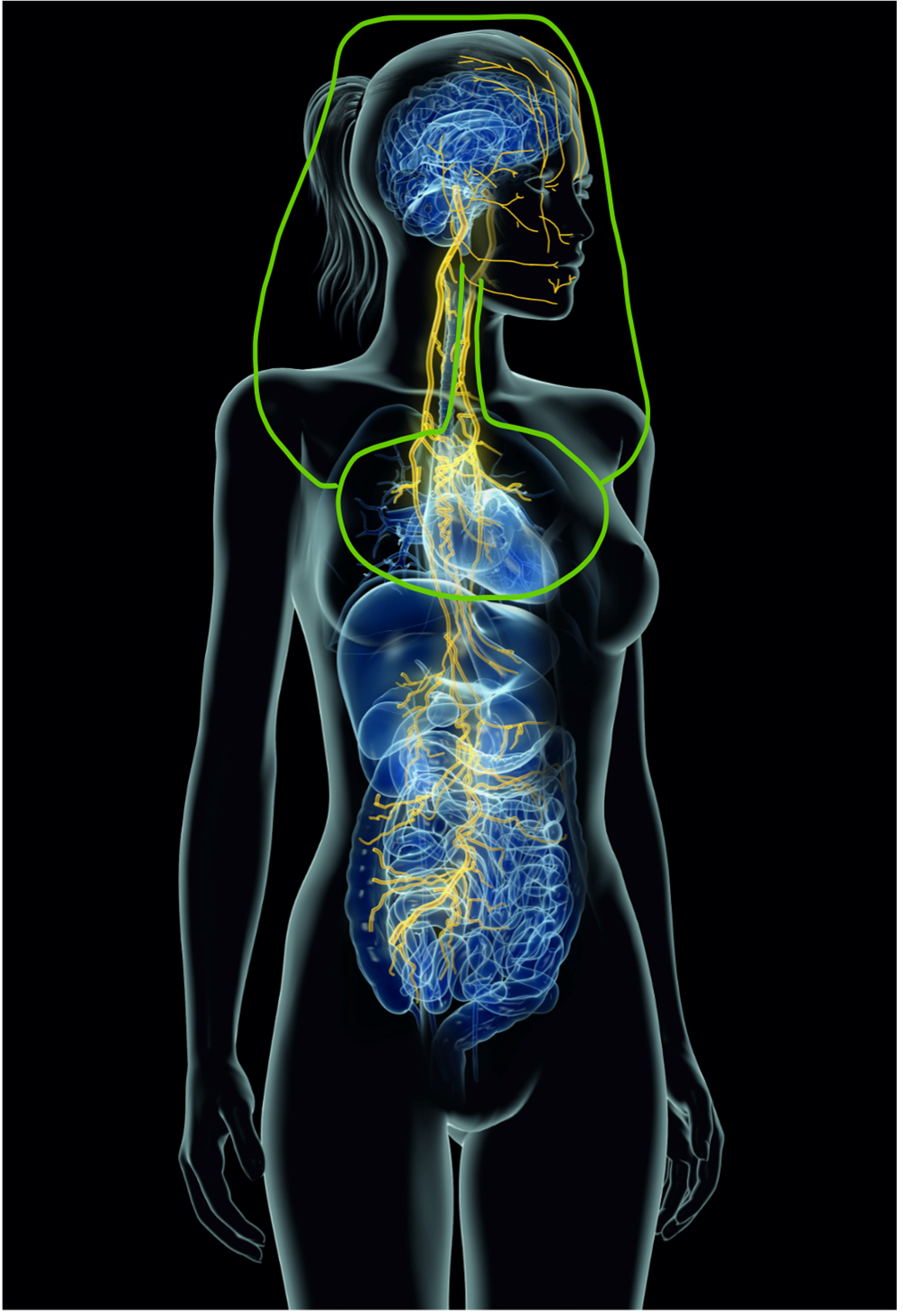
The Left Branch of the Vagus Nerve
The Social Engagement System and the left branch of the Vagus are associated with calm, centered, safe places in our nervous system. The New Vagus is the key to understanding how the Social Engagement System either shuts off or turns on. When the New Vagus is off, we struggle socially because we only have access to the two more primitive brains, which manifests as excessive anger, anxiety, depression, immune dysfunction, chronic pain, etc.
Which of the three brains controls your decisions?
Now I’ll go into more detail about our three brains and explore how they influence each other and alter our behavior and vitality. In the following illustration, I color-coded the nerves associated with each of those brains. Red is the Old Vagus/Shutdown Brain, yellow on the spine area is the Sympathetic Nervous System/Action Brain, and the New Vagus/Calm Down Brain is green.
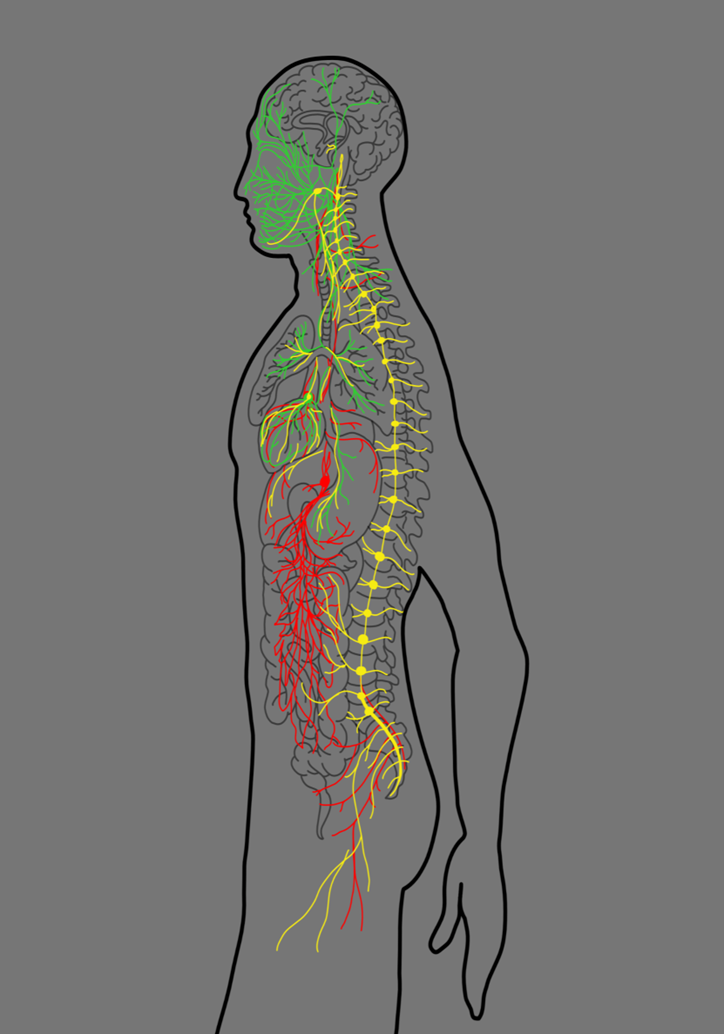
The Color-Coded Nerves of the Three Brains
The traditional scientific view of the Vagus Nerve suggests that most the control over our decisions is from the brain to the body. But Dr. Purges’ research and many other scientists have discovered that most control comes from the internal organs (from the gut) to the cranial brain. Most of the time, the gut-brain controls our thoughts, feelings, and behavior. It decides for us how we respond to our world.
The concept that there is a brain in our gut that unconsciously motivates us might be hard to grasp because it contradicts what we have been told for many years. But according to this new model, 80% of the influence goes from the gut to the cranial brain, with 20% going from the cranial brain to the gut. Therefore, if most of the messages travel from the gut to the brain, we have some conscious control over our physiology, but not nearly as much as we thought.
Our brain in the gut must sense safety for us to thrive.
For civilized behavior and vital health to occur, we must experience feelings of safety, especially a safe connection with other people. Activating civilized behavior requires taming the more primitive responses of fight & flight and shutdown, which is why I call The New Vagus: The Calm Down/Civilized Brain. Consequently, if we’re not socially successful, other people reject us, and we lose social resources. We need to experience social safety/secure social connections to able to turn on the New Vagus; without it, we lose stress resilience, self-regulation, curiosity, spontaneity, joy, love, and deep rest for healing.
Dr. Porges explains that when the New Vagus (or the part of the New Vagus called the Social Engagement System) is activated, it allows us to tame and utilize the ancient brains. By default, our ancient brains are oriented toward behaviors designed to handle dangerous and life-threatening situations. However, when the Social Engagement System is dominant, the primitive behavior of the ancient brains gets transformed into behavior that supports social bonding, healing, creativity, higher brain states, etc.
Therefore, when the New Vagus is dominate:
1. The Sympathetic Nervous System (the Action Brain – which is usually used for fear-based responses) becomes used for play, exploration, deep learning, and cooperative work. When the New Vagus (Calm Down Brain) is dominant, it allows us to be close and vulnerable with other people without getting aggressive and defensive and hurting each other.
2. The Old Vegas (Shutdown Brain) gets recruited; instead of shutting down and playing dead (depression, dissociation, chronic pain etc.), it transforms into feelings of calm, safety, feeling grounded, and stillness. Additionally, when the New Vagus (Calm Down Brain) is dominant, it allows us to access deep spiritual states, including a connection to the Divine.
How can I access the New Vagus/Calm Down Brain to support healing?
We stay connected to other people primarily by using our voice, face and body postures. If we’re talking, singing, or playing games, we use breath and voice. For example, if someone approaches you with good eye contact, a friendly attitude and an interest in connecting, their New Vagus/Calm Down Brain is likely dominate. Alternatively, if they approach you with an aggressive stance, angry face, and tense voice, you can be confident that their Sympathetic Nervous System/Action Brain is dominant. Finally, if you see someone with a collapsed posture, flat voice, and sagging face, they are most likely under the influence of their Old Vagus/Shutdown Brain.
This magnified image from the colored coded nerve chart (earlier in this article) shows you the heart and the nerves associated with the three different brains. You can see all three of them are connected to the heart.
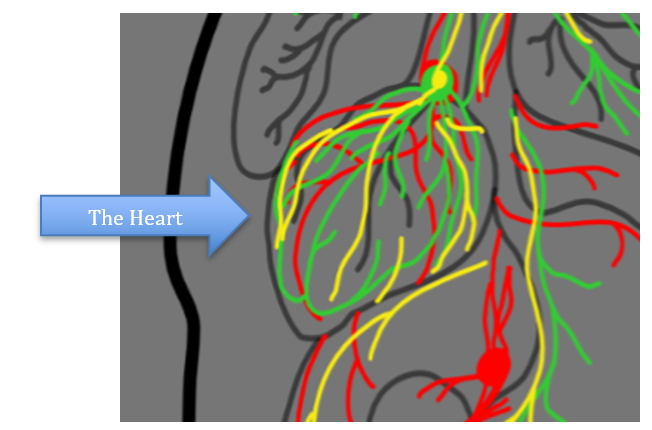
Close Up of the Nerves from the Three Brains Connecting to the Heart
The heart, lungs, and facial nerves are vital for switching ON or OFF different states/survival strategies. Therefore, the key to turning on the New Vagus and keeping it on is to deepen your connection to other people with cooperative and reciprocal interactions and through personal practices that exercise the nerves of the heart, lungs, and face. When the components of the Social Engagement System (The Calm Down Brain) are toned through exercises it is easier for your unconscious to use this survival strategy rather than recruiting fight & flight or shutdown. These exercises must engage the facial muscles, including hearing, eyesight, voice, and breath.
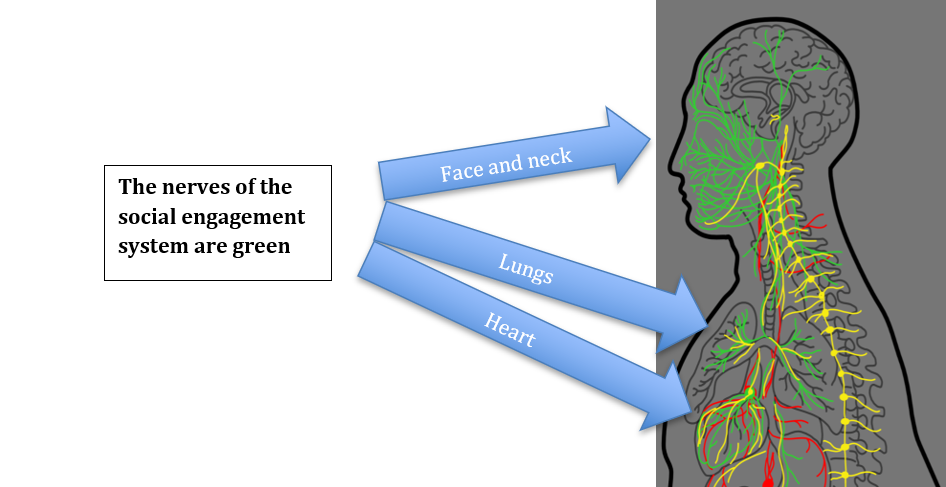
When you find yourself under the influence of the Action Brain and Shutdown Brain too often and for too long, the solution is to exercise the components of the Social Engagement System by regularly connecting with other people who already have access to their New Vagus/Social Engagement System and doing self-care practices. An example of self-care is breathing exercises. You’re exercising your face, heart, and lungs while practicing breath work like pranayama. Pranayama and other breath practices are effective because they vary how you use your face and breath, challenging your subconscious nervous system to change your vagal tone to adapt. Therefore, personal practice and highly reciprocal social interactions stimulate your New Vagus and make it easier to turn on and stay on.
How can I use this science right now to improve my health?
It is one thing to learn a theory and quite another thing to apply it to your life. Therefore, I created a guide for you as a tool to aid you in translating these new scientific principles. I call it The Polyvagal Practice Self-Awareness Guide. You can see in the graphic of The Self-Awareness Guide that the colors coincide with the science I just covered. Red is the ancient Old Vagus/Shutdown Brain. The Sympathetic Nervous System/Action Brain is yellow, and the New Vagus/Calm Down Brain is green. Each of the survival brains changes our physiology and psychology. These changes show distinctly unique temperaments indicated by our voice’s tone, pitch, and rhythm (prosody), facial expressions, and body postures. Therefore, if you want to know which of the three brains is activated in yourself or others, match voice, facial expressions, and body postures to one of the three brains.
https://michaelwestgatestore.com/
The Polyvagal Practice Self-Awareness Guide aims to help you identify the survival states you’re in at any given moment. When you recognize which of your three brains is dominant, you can better determine whether your response to a person or situation is helpful and whether it makes your life worse. And then, you may be motivated to do practices that help shift your unhealthy subconscious reaction to a specific event, person, or situation. Over time you can gain more skill in navigating yourself and others in a way that creates social safety for everyone and deepens your relationships for mutual support and well-being. A shift in the quality of your social connections is the most powerful way to improve your health outcomes.
For examples of practices that support the activation of the New Vagus/greater stress resilience and health, check out these videos and articles:
Let’s Review what we’ve covered:
1. If you struggle with chronic health issues and have spent years going from doctor to doctor with no results, your subconscious (autonomic) nervous system is likely dysfunctional.
2. One of the main components of your subconscious nervous system is the Vagus Nerve, the superhighway your body uses to send messages between your three brains.
3. The purpose of the Vagus Nerve and your three brains is to orient your body (physiology) and psychology to face opportunities or threats effectively.
4. When the part of your nervous system responsible for scanning your environment and choosing which of your three brains to activate becomes misaligned, it can cause you to respond to your environment in ways that make you sick. Essentially, you will become ill if the New Vagus (Calm Down Brain) becomes chronically shut down, making it impossible for you to feel safe even when no real threats exist.
5. Our three brains come from different stages of our evolutionary development. In each stage of development, our nervous system picked up one of the three distinct problem-solving/survival strategies.
6. The Old Vagus/Shut Down Brain, where our nervous system shuts down our energy in the face of an overwhelming threat. Hence, we appeared harmless, hoping the danger loses interest and moves on.
7. The Sympathetic Nervous System/Action Brain is oriented to aggressively confront danger or run away from it (Fight & Flight).
8. The New Vagus/Calm Down Brain enables us to engage in social alliances, friendships, and family groups in a highly cooperative and reciprocal manner. When we successfully connect with other people, we can harness the energy of the two more primitive brains for restorative rest, creativity, deep learning, and intimacy with self and others.
9. The key to keeping the New Vagus active is working to strengthen social bonds and engage in daily self-care practices that exercise the neuropathways of the systems in our body used to connect with other people, i.e., hearing, voice, eyes, facial muscles, breath, and heart (The Social Engagement System).
I hope you found this article helpful in understanding why you or someone you love has struggled so long with chronic illness with no results. I’m working on articles, videos, and a course that explains how to use this chart and proven practices to support you in your journey back to vibrant health.

